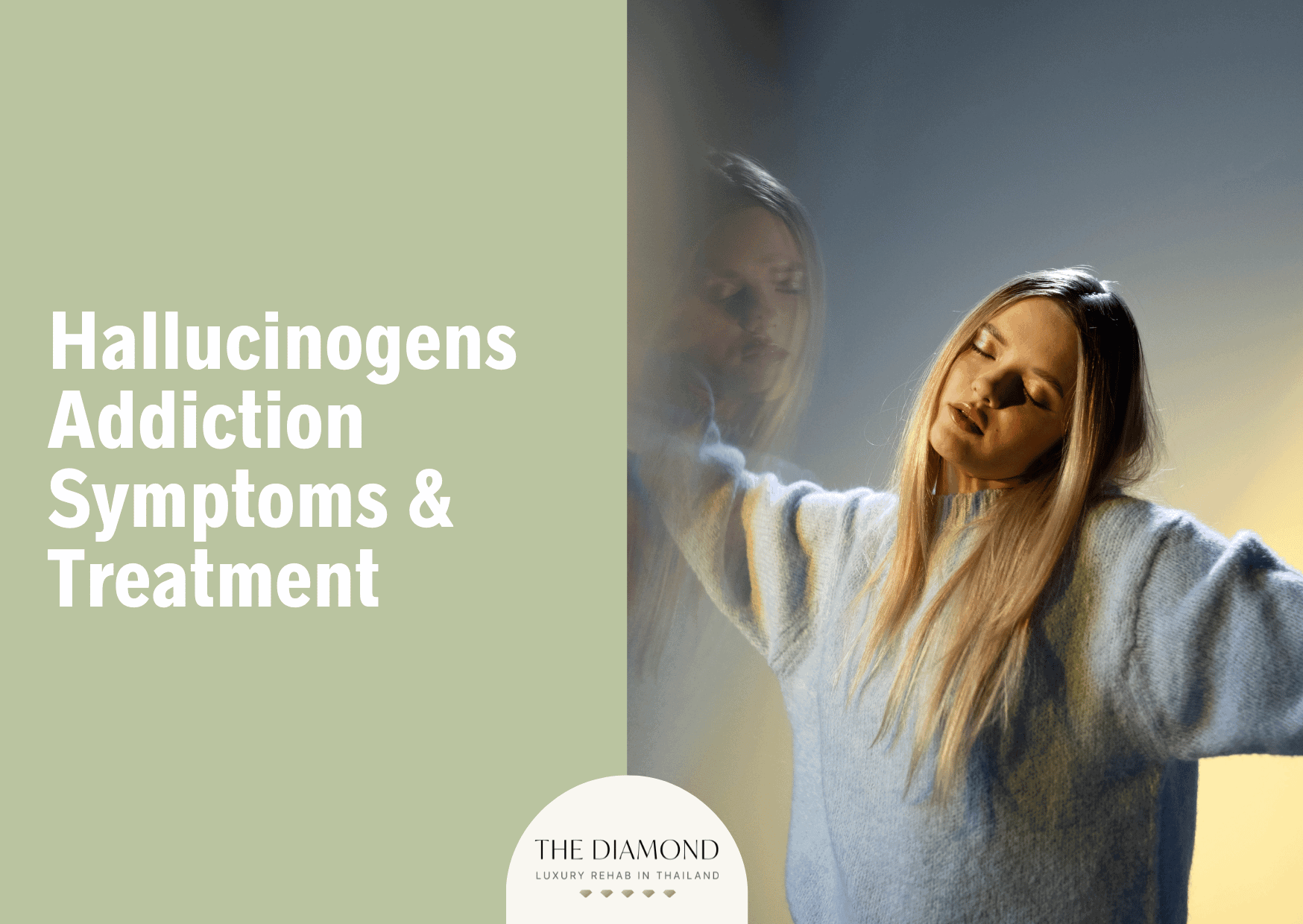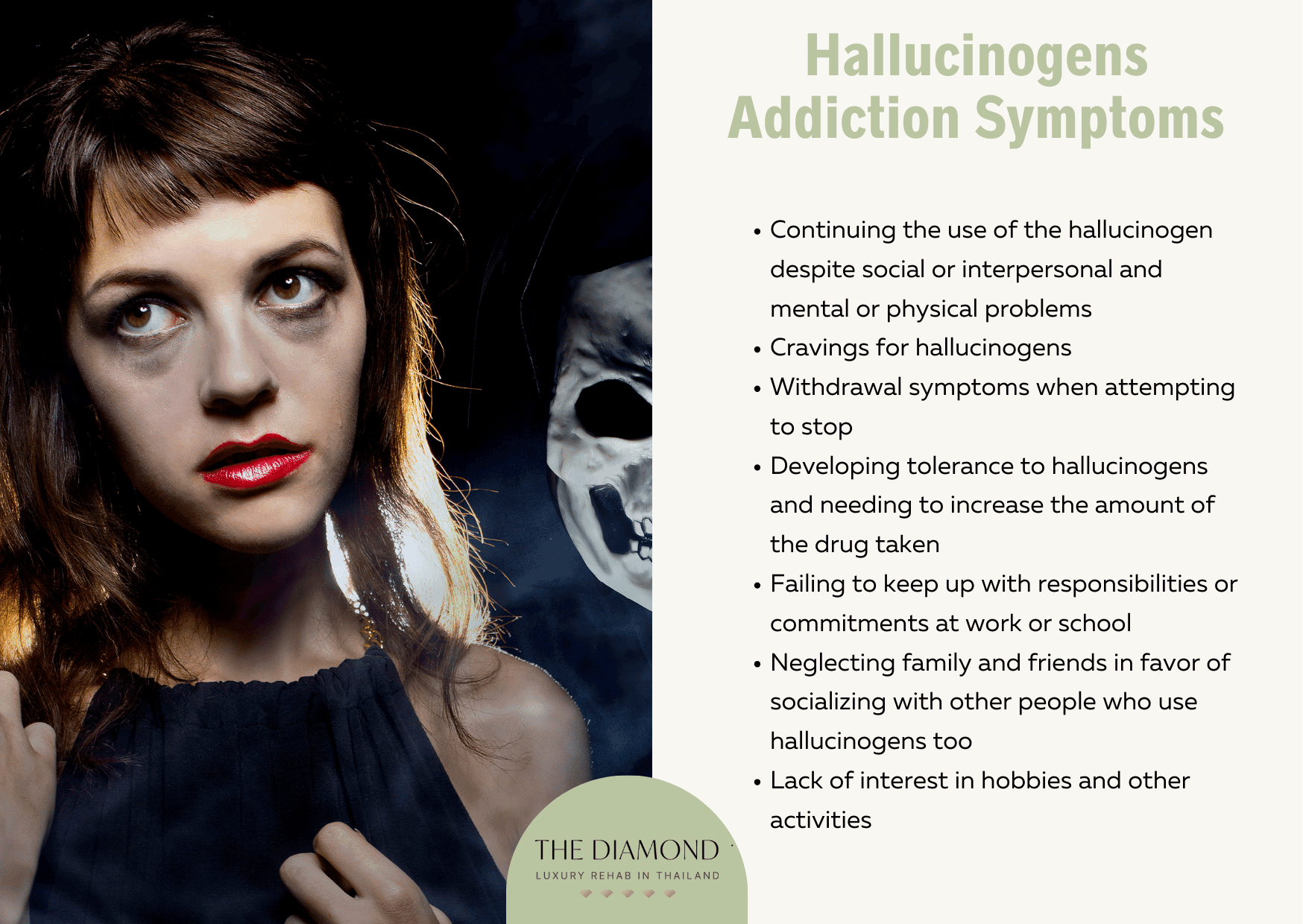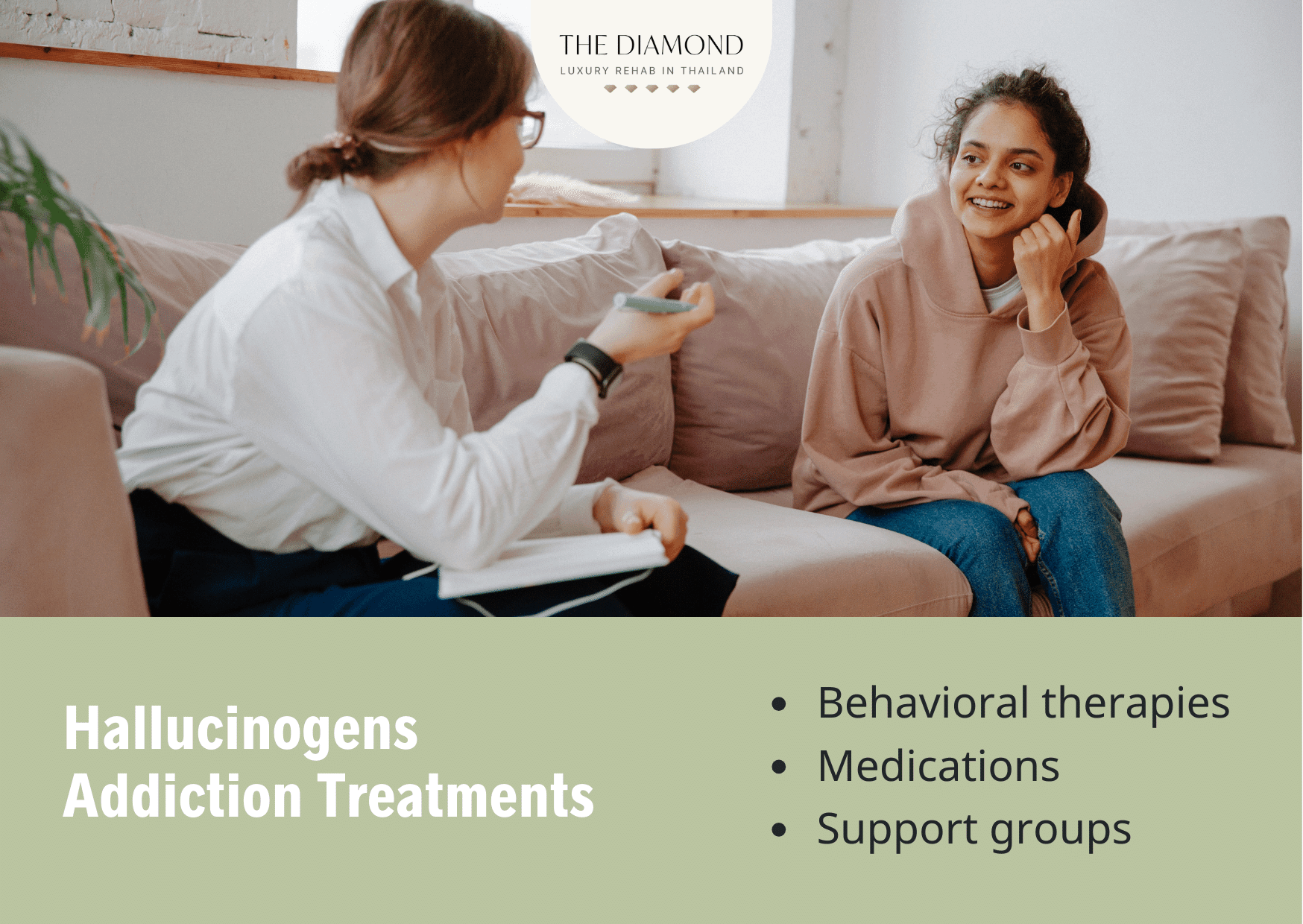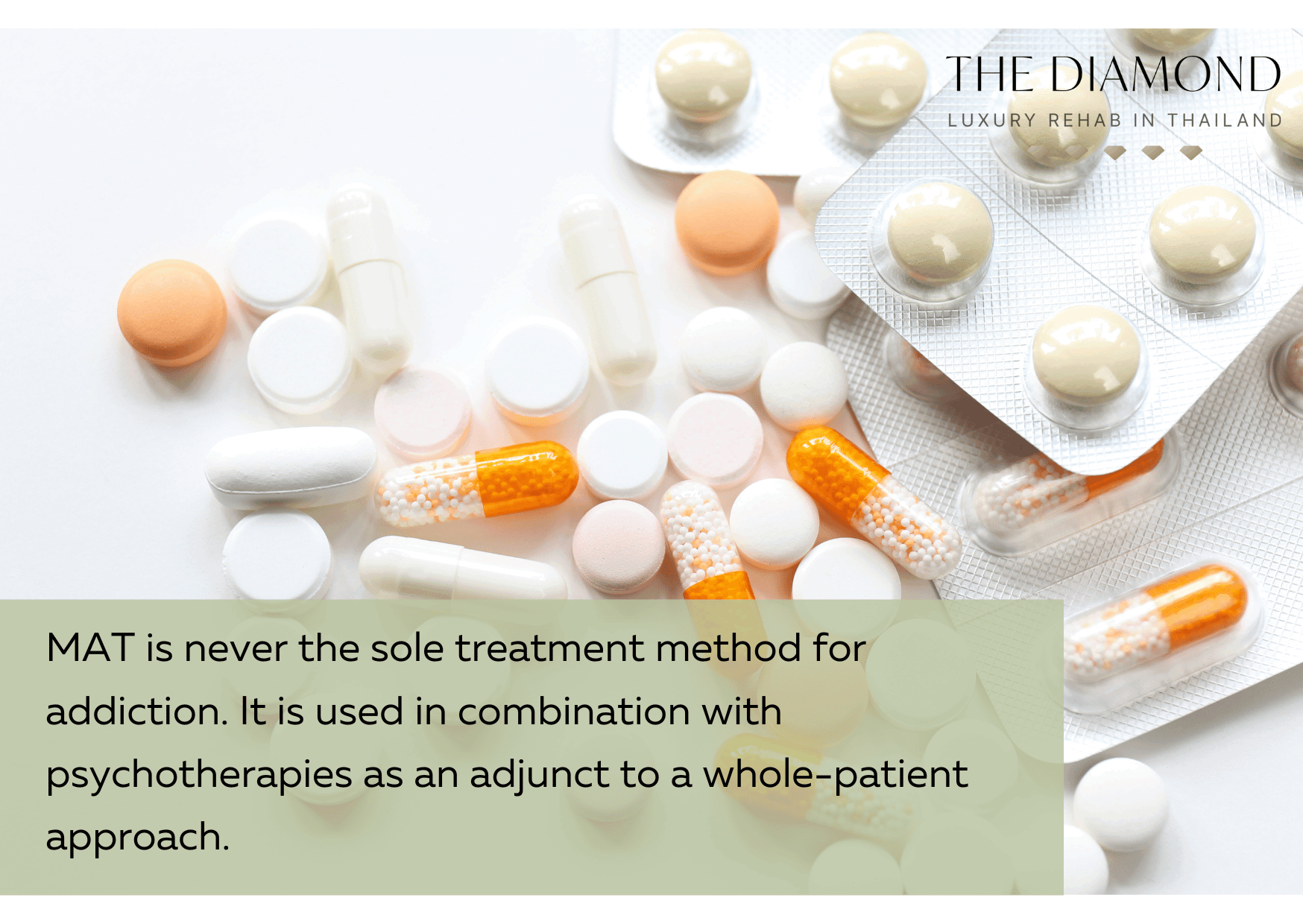Hallucinogens addiction symptoms and treatment

Hallucinogen addiction is the compulsive need to keep using hallucinogen substances despite the problems they cause. In a nutshell, hallucinogens are drugs that cause extreme mood- and mind-altering effects.
There are two categories of these drugs. One category includes classic hallucinogens such as LSD, psilocybin, peyote, DMT, and 251-NBOMe. The second category includes dissociative hallucinogens such as PCP, ketamine, DXM, and salvia.
Symptoms of a hallucinogen use disorder manifest in cognitive, physical, behavioral, and psychosocial ways. Generally speaking, a person with this form of substance use disorder (SUD) experiences strong cravings for hallucinogens and continues to use them regardless of the consequences. In addition, they neglect their responsibilities and other people in favor of hallucinogen use.
Other symptoms of addiction to hallucinogens include developing tolerance and experiencing withdrawal symptoms when not using the drug. People with this condition additionally become frustrated or moody in the absence of hallucinogens.
Treatment for hallucinogen addiction usually revolves around a combination of therapy and medications. Of course, a person with this disorder needs a strong support system as well.
What are the Hallucinogens addiction symptoms?

Hallucinogen addiction symptoms are common signs that indicate that a person has been abusing or has become dependent upon hallucinogens. The most common hallucinogens addiction symptoms are listed below.
- Continuing the use of the hallucinogen despite social or interpersonal and mental or physical problems
- Cravings for hallucinogens
- Withdrawal symptoms when attempting to stop
- Developing tolerance to hallucinogens and needing to increase the amount of the drug taken
- Failing to keep up with responsibilities or commitments at work or school
- Neglecting family and friends in favor of socializing with other people who use hallucinogens too
- Lack of interest in hobbies and other activities
- Taking more hallucinogens than intended
- Spending a lot of time on getting, using, and recovering from these substances
- Using hallucinogens in dangerous situations, e.g., while driving
1. Cognitive symptoms
Cognitive symptoms of hallucinogenic addiction are the effects of these drugs on brain functioning and cognitive functions. According to a 2019 study by Bruijnen et al., published in the journal Drug and Alcohol Review, the prevalence of cognitive impairment in persons with substance use disorder is high. When it comes to addiction to hallucinogens, cognitive symptoms include:
- Impaired focus and concentration
- Delusions
- Hallucinations
- Dissociation
- Poor judgment
- Amnesia, i.e., memory loss
- Paranoia
- Hallucinogen persisting perception disorder (HPPD), i.e., recurrences of specific drug experiences such as visual disturbances and hallucinations
2. Physical symptoms
Physical symptoms include the effects of hallucinogen addiction on the health and body of the affected person. In most cases, physical symptoms of this form of SUD include:
- Nausea and/or vomiting
- Dizziness and lightheadedness
- Perspiration
- Elevated blood pressure
- Accelerated heart rate
- Muscle spasms
- Numbness in extremities
- Vision problems
- Respiratory distress and trouble breathing
- Dry mouth
- Sleep disturbances
- Elevated body temperature
- Developing tolerance
3. Behavioral symptoms
Behavioral symptoms of hallucinogen use disorder refer to the effects of these substances on a person’s attitudes, habits, and daily functioning. The most common behavioral symptoms of addiction to hallucinogens include:
- Violent or aggressive behavior
- Abusing hallucinogens in dangerous situations
- Investing a lot of time in obtaining, using, and recovering from hallucinogens
- Unsuccessful attempts to stop using hallucinogens
- Continuing using hallucinogens even when they cause negative consequences
4. Psychosocial symptoms
Psychosocial symptoms of hallucinogen use disorder are the effects of these drugs on a person’s interactions, relationships, and social functioning. The most common psychosocial symptoms of hallucinogen addiction include:
- Irritability
- Psychosis
- Lack of interest in activities once enjoyed
- Agitation and mood swings
- Frustration
- Aggression
- Social withdrawal
What are the Hallucinogens addiction treatments?

Hallucinogens addiction treatments focus on helping patients stop taking these drugs and recover successfully. That means the hallucinogens treatment supports a patient’s recovery, aids the management of withdrawal symptoms, and helps improve coping skills to react to negative situations and other stimuli in a healthier manner. The most widely used hallucinogens addiction treatments are listed below.
- Behavioral therapies: These approaches focus on changing a person’s behavior, increasing their motivation, improving their coping skills, and encouraging them to commit to a substance-free lifestyle.
- Medications: Medicines work mainly to reduce uncomfortable hallucinogens withdrawal symptoms such as cravings.
- Support groups: The importance of support groups is often overlooked, but they play an important role in the recovery process. People with the same problem, such as hallucinogens addiction, share their experience with this SUD and talk about recovery, obstacles they encounter, and how they overcome them. Their experiences help other people and show they’re not alone. More precisely, support groups allow people to support others while being able to receive support as well.
Depending on the severity of the addiction, a patient needs an inpatient or outpatient treatment program. The latter is suitable for persons whose addiction isn’t severe or for patients who have completed an inpatient program and want to continue with therapies.
On the flip side, an inpatient program is more suitable for severe addiction as it provides more structure. Patients need to spend a specific period of time, e.g., 30, 60, or 90 days in a rehab facility. This type of program is useful because patients receive medical supervision that helps them overcome withdrawal symptoms of hallucinogens.
The most significant treatment options for the treatment of hallucinogens addiction are listed below.
1. Cognitive-behavioral therapy (CBT)

Cognitive-behavioral therapy (CBT) is a type of talk therapy that helps patients manage problems by changing their thinking and behavior patterns. During CBT therapy sessions, a therapist helps the patient become aware of negative or inaccurate thinking. As a result, a patient views challenging situations more clearly and is able to respond to them in a healthier manner.
Through CBT, patients with hallucinogen addiction learn to identify triggers that “urge” them to use these drugs. Once they do that, patients are able to avoid or reduce exposure to those situations or negative stimuli.
Scientific evidence confirms the effectiveness of CBT in the treatment of substance use disorders. For instance, a 2017 meta-analysis by Kathleen M. Carroll and Brian D. Kiluk published in the Psychology of Addictive Behaviors revealed that cognitive-behavioral therapy is more effective than no treatment and minimal treatment in the management of SUDs.
Furthermore, a 2010 study titled, “Cognitive-Behavioral Therapy for Substance Use Disorders” published in the Psychiatric Clinics of North America stated that one of the most significant principles of CBT is that addictive chemicals act as potent reinforcements of behavior. Eventually, the positive and negative reinforcing effects become linked to various external and internal stimuli.
For that reason, therapists use several CBT approaches to empower patients with hallucinogens addiction on their road to successful recovery. Common CBT approaches include acceptance and commitment therapy (ACT), dialectical behavioral therapy (DBT), functional analytic psychotherapy, and mindfulness-based cognitive therapy.
It’s useful to keep in mind that the human experience of cognition consists of our thoughts, perceptions, understandings, and emotions. A therapist doesn’t just observe or control a patient’s behaviors. Instead, they focus on what’s going on in a patient’s mind and how their cognition-related experiences influence behaviors.
What makes CBT for hallucinogen addiction important is that it encourages patients to change their unhealthy behaviors. Oftentimes a person with an addiction wants to stop. They want to change their behaviors and habits, but it’s easier said than done. Once a patient understands the source or trigger of addictive behaviors, they learn coping skills and begin to change the automatic processes that sabotage their efforts to change those patterns. That means a patient adopts a more realistic point of view that leads to a healthier reaction to negative stimuli. As a result, they reduce substance abuse.
2. Motivational interviewing (MI)

Motivational interviewing (MI) is a type of psychotherapy created to help patients find the motivation to make a positive change in their behaviors. As a patient-centric approach, MI is particularly useful for persons with mixed feelings regarding behavior change. That’s what makes it a practical therapy for men and women with hallucinogen addiction and other SUDs.
Persons with addiction are often reluctant to change their behaviors because they lack motivation. In other words, before they even start their recovery journey, they automatically assume it’s going to fail, so there’s no reason to bother.
Lack of motivation is one of the greatest obstacles that prevent a person from getting sober. When it comes to MI for addiction treatment, the main premise is that addicted persons are still aware of the negative consequences of their addiction, to a certain extent.
Every person is in a specific stage of readiness when it comes to behavior change. What a therapist does is that they use MI to facilitate the process of preparing for change. With regular sessions, patients do so by overcoming ambivalence or a fear of change and boosting their motivation.
Principles through which MI works in the treatment of hallucinogen addiction include the understanding that motivation comes from an individual, not outside sources. In addition, the affected person is responsible for resolving ambivalence, not the counselor or therapist. The main goal of a therapist is to guide a patient to recognize and resolve ambivalence in order to increase their motivation levels.
Motivational interviewing is divided into several processes. These include engaging, focusing, evoking, and planning. During sessions, the patients talk about various issues and concerns while a therapist narrows the conversation to the important topics and habits to pave the way to addiction recovery.
At the same time, the therapist elicits a person’s motivation for change by emphasizing the sense of the importance of committing to the treatment. Once a patient commits to a change and is motivated to stick to the recovery program, the therapist helps develop a plan of action.
Through MI, patients learn all the pros and cons of quitting. They come to their conclusions and realize benefits outnumber the risks, which is why they feel encouraged and empowered to commit to sobriety. Results from a study by Satre et al., published in the July 2016 issue of the Journal of Consulting and Clinical Psychology revealed that MI can be an effective therapy method for persons who have depression and substance abuse. This is particularly important if we bear in mind that one of the biggest signs of depression is a lack of motivation and loss of interest. Depression and SUDs often go hand in hand. Motivational interviewing is beneficial for patients in this situation.
3. Medication-assisted treatment (MAT)

Medication-assisted treatment (MAT) is a treatment approach that relies on the use of medications to manage substance use disorders. However, MAT is never the sole treatment method for addiction. It is used in combination with psychotherapies as an adjunct to a whole-patient approach.
According to the Substance Abuse and Mental Health Services Administration (SAMHSA), medication-assisted treatment enhances patient survival, treatment retention, and the patient’s capacity to find and keep a job, and decrease substance abuse or the risky activities associated with it.
The main goal of MAT in the treatment of substance use disorders is to reduce the severity of withdrawal symptoms, decrease cravings, and maintain sobriety. Common hallucinogens withdrawal symptoms include depressed breathing, stiff muscles, rapid heart rate, convulsions, headaches, cravings, sweating, and flashbacks.
The severity of these symptoms vary from one patient to another. The length of hallucinogen withdrawal depends on the severity of the addiction, but it is likely to peak in two to three days and last for a week or up to a few weeks.
Although there is no FDA-approved medication targeted specifically for hallucinogen addiction, healthcare professionals prescribe certain medications to treat various symptoms. The most commonly used medications include benzodiazepines, which reduce anxiety and the sympathomimetic effects of hallucinogens.
Patients additionally receive prescriptions for the management of underlying mental health problems such as depression.It is useful to mention that MAT is usually recommended as a short-term approach, i.e., patients take medications at controlled dosages for a specific period of time.
How do Hallucinogens affect behavior?
Hallucinogens affect behavior by disrupting communication between brain chemical systems throughout a person’s brain and spinal cord. The effects of hallucinogens usually begin within 20 to 90 minutes of ingestion, and they last up to 12 hours, depending on the specific substance.
Certain hallucinogens act on the neurotransmitter serotonin, which controls mood, sexual behavior, sleep, hunger, sensory perception, and other functions. Through their influence on serotonin, hallucinogens alter behavior. This is particularly pronounced in persons with hallucinogens addiction since they become disoriented, confused, and in a state of psychosis regularly.

It is important to remember that hallucinogens distort an individual’s perception of reality. These drugs are unpredictable and so are their effects. When a person’s reality is distorted, their behavior reflects that. This results in violent behaviors, aggression, a sense of distance and estrangement, loss of control, flashbacks, and catatonic syndrome. The latter refers to cases when a person becomes mute, disoriented, lethargic, and makes repetitive and meaningless movements.
Since hallucinogens produce violent and erratic behaviors, people often risk sustaining serious injuries. In extreme cases, this results in lethal consequences.The greatest danger of hallucinogens lies in the fact that hallucinogens produce tolerance, meaning a person needs higher dosages and changes in behavior become more unpredictable.
What medicines can cause Hallucinations?

Medicines that can cause hallucinations usually include prescription drugs for psychiatric conditions, including olanzapine (Zyprexa) for the treatment of schizophrenia and quetiapine (Seroquel) for the treatment of schizophrenia, bipolar disorder, and depression.
Other medicines that cause hallucinations include haloperidol (Haldol), which aids the management of schizophrenia. Additionally, zolpidem (Ambien), which is used as a short-term treatment for sleeping problems, causes hallucinations.
Moreover, medications such as eszopiclone (Lunesta) for insomnia, benzodiazepine tranquilizer clonazepam (Klonopin), benzodiazepine lorazepam (Ativan), Parkinson’s disease medication ropinirole (Requip), and certain seizure medications further cause hallucinations in patients.
Hallucinations are side effects of these medications, but not every patient is bound to experience them. These adverse reactions are relatively rare. However if they do appear, patients must consult their healthcare provider.Certain antibiotics, such as cephalosporins and sulfa drugs, cause this side effect. Besides prescription medicines, illegal drugs cause hallucinations. Apart from LSD and other hallucinogens, these drugs include cocaine and amphetamines.

